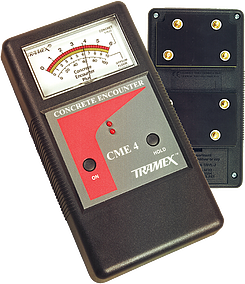
HC-3000
Relative Humidity Moisture Meter Kit with BluePeg Sensor
Low cost, high accuracy relative humidity, temperature and dew point

HC-2994
Concrete Moisture Meter
Measures moisture to 7% and will accept a relative humidity probe

HC-3001
BW/Moisture Non-Invasive Meter Kit with BluePeg Sensor
Non-invasive moisture meter with dual-depth measuring capabilities.

HC-2990
Concrete Encounter (Moisture)
The Concrete Encounter will give you an instant reading of moisture content to over 6% for concrete

HC-2993B.XX
Vapor Emission Test Kit
Inexpensive solution - commonly known as the Anhydrous Calcium Chloride Vapor Emission Test
Concrete Moisture Testing
Moisture is the most common entity that damages concrete and its protective coatings. Due to its porous nature, concrete is prone to issues caused by trapped water. While concrete/water ratios make a difference in permeability, factors such as air humidity, temperature, and surface conditions also affect the rate at which moisture migrates through drying concrete.
Moisture meters are used to locate and measure moisture content in materials such as wood and concrete. They are often utilized by flooring installers and other testing applications to detect moisture up to 1” deep. It is very important to test concrete humidity as water continues to pass through even after it hardens. While concrete moisture doesn’t have a huge impact on outdoor applications, it is critical in indoor installations.
Problems arise from high levels of detected moisture. Trapped water can cause mold and mildew, bubbles in flooring, or even degradation of materials. No single test reveals everything about a concrete’s qualities. Therefore, multiple moisture tests are essential and should be utilized accordingly.
ASTM F2170 standards specify that in situ probes should be used to determine if a concrete slab is in good condition to be sealed or covered by a floor. This methodology of measurement provides accurate and reliable data for making installation decisions. Surface-based test methods are generally unreliable in evaluating moisture in a drying slab.
The levels of moisture in a drying slab will be higher at the bottom but will disperse over time once the slab has been sealed. So, any testing method that does not take this into consideration and measure below the surface and into the slab will not provide accurate data as to what will occur after the flooring is installed.
Humboldt provides a variety of instruments utilizing different methodologies for concrete moisture testing.
The low-cost, high accuracy HC-3000 Relative Humidity Moisture Meter Kit with BluePeg Sensor (ASTM F2170) provides in-depth moisture testing of concrete for contractors, floor covering installers and restoration specialists.
The HC-2994 Tramex CME Xpertil Concrete Moisture Meter operates on the principle of non-destructive impedance measurement to quickly and easily measure moisture content and accepts a relative humidity probe.
The HC-3001 BW/Moisture Non-Invasive Meter Kit with BluePeg Sensor features dual-depth measuring capabilities. The RH BluePeg Probe can be added for use as a Thermo-Hygrometer or for in-situ probe testing following the ASTM F2170 standard.
The HC-2995A Concrete Inspection Kit comes complete for testing concrete moisture as specified in ASTM F2659 and ASTM F2170. The kit features the HC-2994 moisture meter and Hygro-i® relative humidity probes.
The hand-held HC-2990 Concrete Ecounter determines moisture levels in concrete floors utilizing non-destructive impedance measurement.
The HC-4972 Cementometer Concrete Moisture Meter is calibrated for standard type I, II and III cements and is user-programmable with up to ten mix designs.
The HC-2993B and HC-2993A Vapor Emission Test Kits (12-pak or 3-pak) allow the user to easily quantity the volume of water vapor emitted from a concrete slab over a 24-hour period.
Humboldt’s concrete moisture testing equipment is available for fast delivery with easy online ordering. If you have questions or need help selecting equipment, please call us at 1.800.544.7220 or use our Ask Humboldt form.

